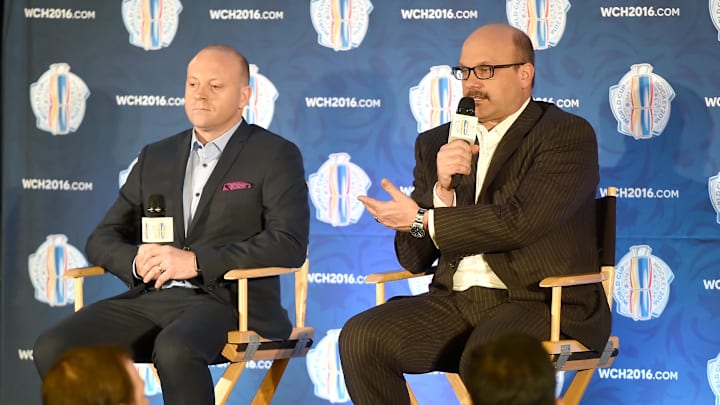What a picture that is above, huh? Oilers general managers past and present in the same picture - little did we know at the time that one would be the predecessor of the other. In case you are just tuning in, the 2016 draft results are here, while the 2015 draft results are here.
At this point the Oilers were still rebuilding (although at the time we didn't know that) and thus the theme was continuing to build through the draft rather than quality over quantity. Let's see how they made out.
This time around the Oilers had just made the playoffs for the first time in 11 years. Thus this accounts for the lowest draft position they'd had in quite some time, overcoming what at the time were perennial playoff chokers in San Jose, only to fall to Anaheim in the next round.
Round one - Kailer Yamamoto, 22nd overall
Yamamoto was pegged as a guy who would play on the right wing in the top six forward group for the Oilers, a roster weakness at the time. He was drafted after finishing his third year of junior on a high note, with 99 points in 65 games. Yamamoto was also in the unique position of being an absolute shrimp of a player - he was only listed at 5' 8" and 153 lbs, numbers that are incredibly small for an NHL player. However, this was buoyed by the fact that he had a streak of physicality to his game that no one really expected, which made up for his small stature. This earned him the nickname Mighty Mouse.
Learning from the faux pas the Oilers made with Jesse Puljujarvi the previous fall, after Yamamoto put up a mere three assists and appeared only okay in the early going, he was sent back to junior in his rookie season after nine games. This meant his Entry Level Contract (ELC) didn't kick in until the following season. He then went back to junior and put up another 64 points in the remaining 40 games of the WHL season. He then spent the next two seasons bouncing back and forth between Bakersfield and the Oilers before the covid-shortened season of 2020-21, where he would put up 8-13-21 in 52 NHL games, staying up with the Oilers for good.
Yamamoto then followed that up with what turned out to be his career high, 20-21-41 in 81 NHL games. We all thought he'd won the war for a top six RW spot with Puljujarvi. However, by this time he was off his ELC and in order to avoid arbitration the Oilers signed him to a new short term contract, which challenged him to repeat the previous season's performance. This was a task in which he largely failed after bouncing around the lineup and being a healthy scratch for stretches as well, mustering up only 10-15-25 in 58 games the next season.
In a cap crunch by now, the Oilers needed to save cap space so they traded Yamamoto to Detroit -- along with Klim Kostin -- where he was immediately bought out and became an unrestricted free agent. (That buyout cap hit is still on Detroit's books for next season.) Now as an unrestricted free agent as a result, Yamamoto signed a one-year contract with his hometown Seattle Kraken. He largely repeated the previous season's results, only regressing even further, going 8-8-16 in 59 games for the Kraken. In part because the team as a whole was worse than the Oilers, his +/- also nosedived from +12 in his final Oilers season to -9 with the Kraken.
The Kraken did not re-sign him and thus at the time of this writing, Yamamoto remains an unrestricted free agent with an unclear future ahead of him. He's not coming back to the Oilers as they don't need him anymore - they have much better depth at forward and have multiple prospects knocking at the door, meaning they don't need Yamamoto in their lineup at this point in time. It's hard to say whether someone will take a chance on him or not. It's possible, but he may have to continue his career in Europe. Two straight years of regression means he now comes with more baggage and risk then he did earlier on in his career.
Hit or Miss? Miss. Although the Oilers made out better with Yamamoto than with Puljujarvi the previous season, the fact that he doesn't have a place to play at this point in time means his NHL career may in fact be over before he hits his prime producing years.
Who did the Oilers miss out on? Goalie Jake Oettinger (Dallas), Morgan Frost (Philadelphia), Henri Jokhiharju (Chicago). Honourable mentions to bottom six forwards Ryan Poehling (Montreal) and Kostin (St. Louis). Those first three hurt a lot as Oettinger would have formed a formidable tandem between the pipes with Stuart Skinner. Frost meanwhile, appears to be the real deal for Philly as he's a two-time 40 point scorer and their second line centre - obviously that spot isn't available on the Oilers now. Jokhiharju would go on to be traded to Buffalo, where he's partnering with Owen Power right now. Tolvanen just cracked the 40 point barrier with the Kraken and is a winger on a pretty good third line in Seattle with Yanni Gourde and Olivier Bjorkstrand - hey, you can never have too much bottom six depth. Kostin we'll hear more about in later rounds.
